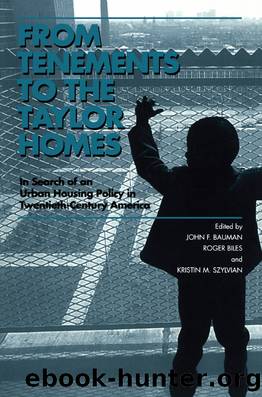From Tenements to the Taylor Homes by John F. Bauman Roger Biles Kristin M. Szylvian

Author:John F. Bauman, Roger Biles, Kristin M. Szylvian [John F. Bauman, Roger Biles, Kristin M. Szylvian]
Language: eng
Format: epub
ISBN: 9780271020129
Goodreads: 9313459
Publisher: Penn State University Press
Published: 2000-08-01T00:00:00+00:00
A Program to Save the Cities
During the middle decades of the twentieth century, observers of the urban scene became increasingly apprehensive. Since 1920, population growth in most of the nationâs great cities had slowed from the previous centuryâs breathtaking pace to a crawl, and in a few cities the population had even declined. Yet suburban towns continued to attract people. Even more disturbing, affluent urban dwellers were defecting in increasing numbers to the suburbs, and the downtown commercial districts and the posh residential areas that depended on them began to decline. Big city newspaper publishers, department-store owners, members of the chambers of commerce, and government officials became alarmed that the loss of tax revenues threatened the economic survival of Americaâs cities.
Urban experts and leaders believed the problems of the city were essentially physical in nature. They associated âdecentralizationââthe movement of people and businesses from the city to the suburbsâwith the spread of slums and blight from the inner-city industrial areas to the residential neighborhoods. To retain middle- and upper-class residents and to reverse the spread of blight, the defenders of the city wanted to upgrade the aging building stock, rebuild inadequate street plans, and promote new downtown development.5
The promoters of urban redevelopment encountered two difficulties. First, slum landowners were often reluctant to sell their properties, and second, slum lands cost more in their present profitable state than after they were redeveloped. To solve these problems, the National Association of Real Estate Boards in 1941 proposed setting up metropolitan redevelopment commissions, which would acquire blighted areas through the power of eminent domain and, using subsidies known as write-downs, sell them to private developers at below-market prices. The idea caught on, and between 1941 and 1948, legislatures in twenty-five states, including Missouri, passed urban redevelopment acts. Yet because all but two of the states refused to provide subsidies, big city mayors were forced to turn to the federal government for financial aid for redevelopment.6 A conflict between two major lobbying groups, however, stymied the efforts to pass an urban redevelopment bill in the Congress between 1943 and 1948. On one side, a liberal coalitionâincluding the Truman administration and social welfare, housing, and mayorsâ organizationsâinsisted that public housing was essential to a successful urban revival program. Cities needed public housing, their leaders argued, to redevelop the slums and alleviate the postwar housing shortage. On the other side, the conservative real estate and banking industry adamantly opposed the funds for public housing as a âsocialisticâ intrusion in the private market. Finally, Harry Trumanâs come-from-behind victory in the 1948 presidential election provided the liberal forces with the political momentum to pass the Housing Act of 1949.7
The Housing Act of 1949 finally gave big-city officials the money to carry out their long-deferred dreams of urban redevelopment. Title I authorized one billion dollars in loans to help cities acquire slums and blighted land for public or private redevelopment. It also allotted one hundred million dollars for write-down grants to cover two-thirds of the difference between the cost of slum land and its re-use value.
Download
This site does not store any files on its server. We only index and link to content provided by other sites. Please contact the content providers to delete copyright contents if any and email us, we'll remove relevant links or contents immediately.
Nudge - Improving Decisions about Health, Wealth, and Happiness by Thaler Sunstein(6644)
iGen by Jean M. Twenge(4708)
The Fire Next Time by James Baldwin(4352)
Adulting by Kelly Williams Brown(3683)
The Sports Rules Book by Human Kinetics(3597)
The Hacking of the American Mind by Robert H. Lustig(3590)
The Ethical Slut by Janet W. Hardy(3513)
Captivate by Vanessa Van Edwards(3310)
Mummy Knew by Lisa James(3176)
In a Sunburned Country by Bill Bryson(2954)
Ants Among Elephants by Sujatha Gidla(2930)
The Worm at the Core by Sheldon Solomon(2929)
Suicide: A Study in Sociology by Emile Durkheim(2617)
The Slow Fix: Solve Problems, Work Smarter, and Live Better In a World Addicted to Speed by Carl Honore(2579)
Humans of New York by Brandon Stanton(2383)
Handbook of Forensic Sociology and Psychology by Stephen J. Morewitz & Mark L. Goldstein(2380)
Blackwell Companion to Sociology, The by Judith R. Blau(2320)
The Happy Hooker by Xaviera Hollander(2277)
Outliers by Malcolm Gladwell(2263)
